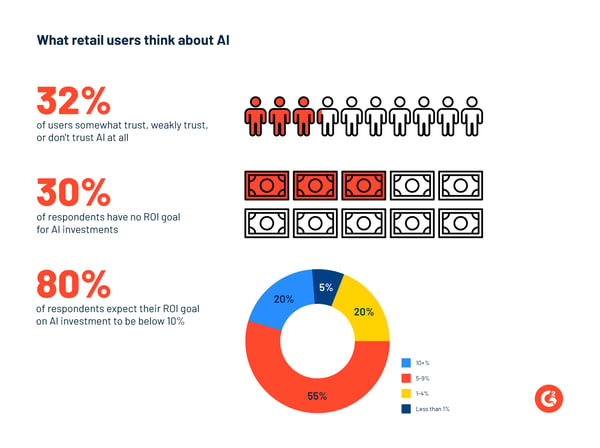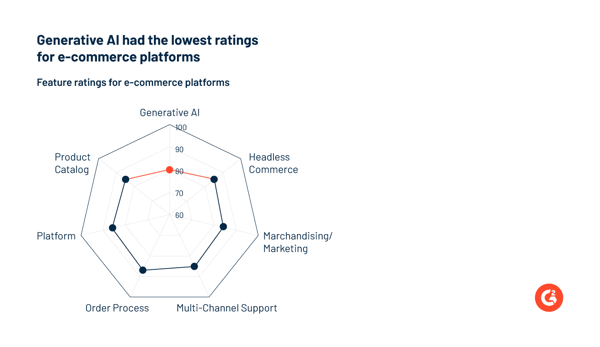This post is part of G2's 2025 digital trends series. Read more about G2’s perspective on digital transformation trends in an introduction from Tim Sanders, VP, research insights, and additional coverage on trends identified by G2’s analysts.
Retailers are still waiting to see significant ROI with AI
Prediction
AI in retail isn't fully mature. By 2025, vendors will have to better understand AI's nuances to enhance products and boost customer adoption.
AI has made notable strides in retail, such as helping shoppers through chatbots, website personalization, product recommendations, etc.
However, many AI-powered solutions still face challenges like a lack of contextual understanding of customers’ preferences while recommending products, unsatisfactory responses by shopping assistants, and inaccurate demand forecasting resulting in supply chain disruptions.
This is because AI in retail is in its early implementations: primarily experimental rather than widely adopted. The AI models currently trained and deployed encounter challenges related to data quality, integration, and real-world effectiveness.
Over time, as vendors gain better insights and experience, they will fine-tune their AI solutions, ensuring AI investments yield tangible returns such as a boost in customer experience, accurate prediction, and cost reduction through better employee productivity.
In 2025, software vendors need to focus on these gaps while working on the advancements of their retail AI systems. They must provide customized solutions that address distinct operational needs and consumer demands. For instance, consumers who purchase packaged goods (CPG) exhibit different behavior from those who purchase durable goods.
Furthermore, cultural nuances from various regions may be challenging as most large language models (LLM) are trained on data in English.
Retailers trust generative AI (GAI), but 80% expect low ROI from it
G2’s 2024 Buyer Behavior Report highlighted findings from a survey completed by 1,800 business users from all major industries, including retail. Users across all industries generally trust generative AI, but 32% of retailers mentioned that they somewhat, weakly, or don't trust it. At the same time, 30% had no ROI goal for AI investments, and of those who did, 80% expected an ROI of less than 10% in 2024.

This indicates that while retailers understand AI’s potential, they are not yet convinced that it will be beneficial in the short term. They may also need to invest more to get more significant ROI, which creates a vicious cycle: retailers aren't convinced that it's worth spending much on AI, but they can only be convinced by spending more.
There’s more. Although AI has enhanced the shopping experience compared to older technologies, concerns about privacy and ethical use of data persist. Addressing these issues is essential for building confidence in AI solutions.
This lack of trust in AI has led to skepticism about its ROI. Many retailers have yet to set clear ROI goals, as current AI investments are anticipated to yield modest returns. This mistrust and uncertainty about ROI are hindering the growth of AI in retail.

Vendors must acknowledge these challenges to address them. They must enhance their AI capabilities and retail-specific features.
Finally, vendors will need to showcase their improvements through case studies, testimonials, and reviews.
Refinement over new investments is critical for the success of AI in retail
It's time for software vendors to do more to justify the return on previous investments in AI and convince buyers to spend more. Vendors must prioritize retailers' pain points and incorporate essential feedback to refine their existing AI systems and strengthen the reliability and effectiveness of the AI infrastructure.
The good news is that AI for e-commerce takes less time to achieve ROI, and GAI has already significantly impacted personalization in 2023. In 2025 and beyond, we can expect AI to evolve more within the retail sector. Enhanced algorithms backed by accurate data and transparency will win the trust and empower retailers to understand consumer trends more effectively, fostering better decision-making.
Learn more about how AI can revolutionize e-commerce personalization through 2024 trends!
 This article is co-written by Gabriel Gheorghiu, G2 research principal, ERP, CRM, and HCM.
This article is co-written by Gabriel Gheorghiu, G2 research principal, ERP, CRM, and HCM.
Edited by Supanna Das


 by Subhransu Sahu
by Subhransu Sahu
 by Subhransu Sahu
by Subhransu Sahu
 by Subhransu Sahu
by Subhransu Sahu